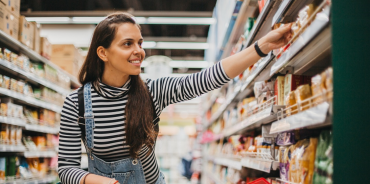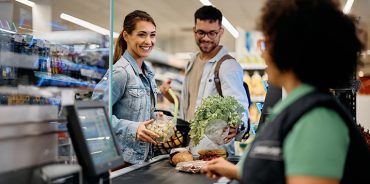Why agencies need to pay attention to closed loop measurement
What matters most in media measurement?
That’s a trick question, of course, because the answer is likely to change based on where your responsibilities lie. If your role focuses on the top of the marketing funnel, where it’s all about awareness, then you’re more likely to be interested in a metric like impressions than you are by sales uplift. Vice versa, someone with an eye on retention is likely to be a little less concerned about reach than they are repeat purchases.
These are generalisations, of course. The media landscape of today is connected and collaborative, with plenty of overlap between goals and objectives. Suggesting that consumer awareness doesn’t have an impact on – or matter to – a shopper marketer is patently untrue.
Every stage of the funnel is important to a consumer packaged goods (CPG) brand’s ongoing commercial health, which is one of the reasons that dunnhumby is so focused on helping shopper, brand, and agency marketing teams measure their performance in an integrated and cohesive way. Just as you need to be able to reach the right people across the whole of the funnel, you need to be able to quantify the true impact of doing so as well.
At the same time, there are clear signs that some things do matter more when it comes to measurement. In the results of a study released last April, 67% of CPG marketing professionals stated that return on advertising spend (ROAS) was the most important measure of campaign performance[1]. That compares to 16% who said “reach”, and 7% who cited “clicks and online engagement”.
While that might not be a particularly surprising fact in isolation, it becomes more interesting when we look at the measurement techniques that brands actually employ. A late 2021 survey of CPG marketers in North America revealed that while almost three-quarters use marketing mix modelling (74%) and incremental sales lift (71%), only a tenth or so track their investment returns (13%). Importance and intent are apparently severely misaligned.
This disconnect is almost certainly due to the fact that it can be very difficult to achieve any degree of accuracy when it comes to measuring ROAS through traditional media channels – particularly for agencies.
Say you run a two-week long television campaign, for instance. There are a number of ways to measure that: viewership figures, footfall attribution, purchasing intent as expressed by focus groups, and even sales. The problem with these metrics is that they’re largely inferred. You can probably say that your campaign drove a certain response, but it’s hard to say for sure – and “probably” doesn’t cut it when it comes to proving ROAS to a client.
This is where retail media, and specifically it’s capability for closed-loop measurement, makes such a difference.
Linking ad exposure to sales impact
There’s a good chance that you’ve already heard about the concept of closed-loop measurement. Nonetheless, having seen different definitions of that phrase begin to spring up across the industry, I want to take a moment to explain how we see it here at dunnhumby.
At the heart of retail media is the opportunity for CPGs to run ad campaigns using retailer-owned inventory. In grocery specifically, that opportunity is truly gigantic, encompassing everything from digital media like websites and apps through to physical assets like point-of-sale (POS) displays, smart screens, in-store radio, magazines, and more. Essentially, if shoppers can interact with it in some way, there’s probably a way to advertise on it.
There are numerous advantages to that, many of which have been discussed by my colleagues on this very blog. There’s the chance to reach customers just as they’re making their mind up about what to buy. There’s the option to find highly specific audiences matched to different objectives. From a measurement perspective, though, it’s the ability to link ad exposure and sales impact that really counts.
That’s what closed-loop measurement is. It gives you the ability to say with absolute certainty that the action you took resulted in a sale, because both of those things occur within a closed environment. Whether it’s a highly personalised offer sent via a loyalty app, or the ability to say that sales uplift was highest in stores carrying your POS campaigns, closed-loop reporting provides a tangible link between what people see and what they buy.
Critically, this doesn’t end at the till, either. The best retail media programmes are built using customer loyalty data, ensuring that advertisers also have access to a long-term picture of shopper behaviours. Not only can they see where campaigns have resulted in an immediate sale, brands can also track longer term factors like retention and uptrading.
For agencies, this proof of performance is becoming increasingly key. Almost a fifth (18%) of chief marketing officers specified “customer acquisition, retention, and engagement” as their top priority in 2022[2], more than said the same of “brand building, awareness, and rebranding” (14%) and even “growth and expansion” (6%). Closed-loop reporting gives agencies the ability to support that ambition in an accountable way.
Those organisations that are already engaged with retail media (and by default, closed-loop reporting) agree. In a recent dunnhumby study[3] of more than 300 CPG and media agency professionals from around the world, measurement was seen to be the most “satisfying” aspect of their retail media experiences, outstripping execution, pricing, and even targeting. While there’s always room for improvement, retail media measurement clearly delivers.
As with anything else in life, the only way for agencies to refine and improve is to learn from prior experiences. To deliver better results for their clients, agencies need to look in detail at past campaigns and learn how to adapt their strategies based on what worked, and what failed to resonate.
That’s what closed-loop reporting provides; a true and open view of performance. Not one that’s inferred, or obfuscated by questions of possibility – just a concrete connection between campaign and customer. For agencies that want to build better, deeper, and more collaborative relationships with their clients, closed-loop reporting is the best place to start.
[1] Survey: ROAS Most Important Performance Indicator to CPG Marketers – Path to Purchase Institute, 26 April 2022
[2] The State of Marketing Budget and Strategy 2022 – Gartner, 24 May 2022
[3] Retail media: the buyer’s view – dunnhumby
TOPICS
RELATED PRODUCTS
Make Retail Media work for your business with Customer Data Science
Retail Media solutionsPlan, execute, and measure the impact of omnichannel Retail Media
dunnhumby Sphere - Retail Media PlatformThe latest insights from our experts around the world



